Range Rover Evoque: Manual Transmission/Transaxle External Controls
Torque Specifications

External Controls - Component Location
COMPONENT LOCATION
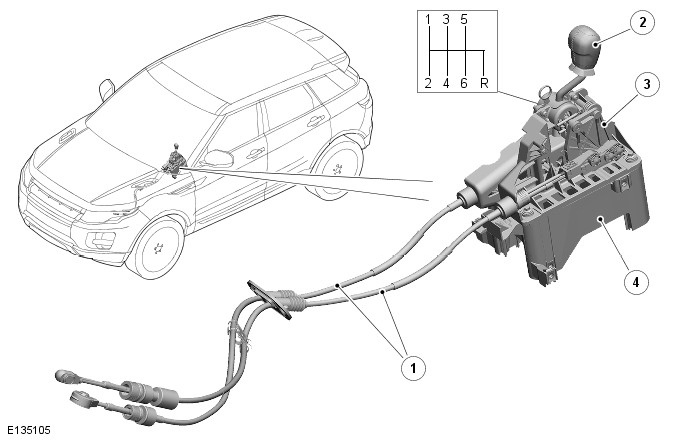
- Shift cables
- Gear knob
- Selector lever assembly
- Selector lever mounting plate
External Controls - Overview
OVERVIEW
The manual transmission external controls comprise a selector lever and two shift cables. The selector lever allows the driver to select 6 forward gears and reverse gear.
The selector lever assembly is located in a central position on the transmission tunnel, between the driver and passenger seat. The assembly is secured to the tunnel with four bolts. The selector lever assembly is a non-serviceable mechanical assembly.
Selections made using the selector lever are passed to the transmission lever arm by two shift cables. Ball pins on the selector lever provide for attachment of the shift cables.
The selector has a speed dependant solenoid interlock. This ensures that the driver cannot select reverse gear when the vehicle is moving forwards above a predetermined speed.
External Controls - System Operation and Component Description
System Operation
OPERATION
Movement of the selector lever in a longitudinal direction pushes or pulls the transmission selector lever in the direction of the selected gear.
Movement of the lever in the lateral direction across the gate pushes or pulls the transmission selector lever to correspond to the gear selected.
Reverse gear is inhibited using a solenoid interlock located on the selector lever assembly. When the solenoid is energized, movement of the lever plate is restricted to prevent the reverse gear position from being accessed. The solenoid is activated at speeds in excess of 25 km/h (15 mph) to prevent inadvertent selection of reverse gear. The solenoid is deactivated at speeds below 15 km/h (9 mph). The CJB (central junction box) controls the solenoid operation using speed signals received on the high speed CAN (controller area network) bus from the ABS (anti-lock brake system) module.
Component Description
DESCRIPTION
Selector Lever and Shift Cables
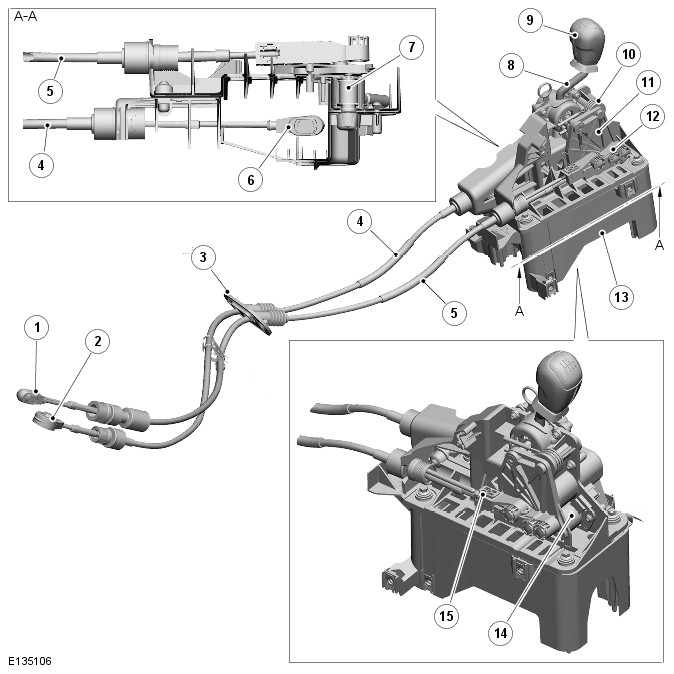
- Lateral shift cable - transmission attachment
- Longitudinal shift cable - transmission attachment
- Bulkhead seal
- Longitudinal shift cable
- Lateral shift cable
- Longitudinal cable attachment to selector lever ball end
- Reverse interlock solenoid
- Gear selector lever
- Gear knob
- Centering spring
- Lever plate
- Lateral cable attachment to lever plate ball end
- Mounting plate
- Reverse interlock solenoid
- Lateral cable adjustment button
The selector lever assembly is a plastic moulded construction. The lever is attached to a gimbal mechanism which allows easy movement in the lateral and longitudinal planes.
The lever has a ball end on its base to which the longitudinal cable is attached. This cable passes all longitudinal movements of the lever to the transmission. A second ball end is attached at 90 degrees to the lever and engages with a centering spring. The centering spring returns the lever to a position between 3rd and 4th gears when neutral is selected.
The second ball end locates in a rotating lever plate. This plate is spring loaded and has a ball end for attachment of the lateral shift cable. The lever plate rotates with movements of the selector lever from side to side and passes lateral movements of the selector lever to the lateral shift cable.
The two shift cables have abutments which locate in the selector lever assembly and in brackets on the transmission. The lateral shift cable is adjustable at the cable ball end attachment. Both shift cables have eye ends which locate on ball ends on the transmission selector shift mechanism levers.
The lateral shift cable has an adjustment setting mechanism at the selector lever end. The purpose of the mechanism is to accommodate vehicle build tolerances. This ensures that the selector lever movements are correctly aligned with movements of the transmission selector lever. This is essential to ensure the correct operation of the selector mechanism.
The longitudinal cable does not require any adjustment or setting.
Cable Setting Procedure
The correct cable adjustment is achieved by use of a yellow adjustment button in the selector lever arm eye end of the lateral shift cable.
Ensure that the transmission is in neutral and release the yellow adjustment button. Allow the centering spring to center the selector lever in the lateral direction.
Once the cable is in the correct position, the yellow adjustment button can be pressed back into the locked position to engage with the serrated portion of the cable. Ensure that the selector lever is not moved before the button is pressed.
Check the cable for the correct setting by selecting 3rd gear and checking that the lateral movement of the selector feels symmetrical.
The cable should be reset whenever any part of the transmission selector has been disturbed or replaced, including the transmission, cables and selector lever assembly.
Gearshift Linkage
Removal
NOTES:
Removal steps in this procedure may contain installation details.
Some variation in the illustrations may occur, but the essential information is always correct.
1. Refer to: Air Cleaner (303-12, Removal and Installation).
2.
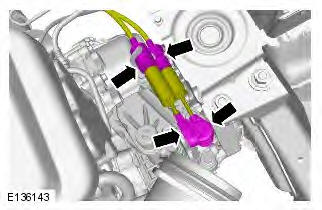
3. Torque: 24 Nm
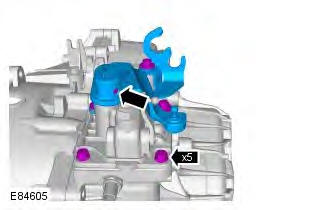
4.
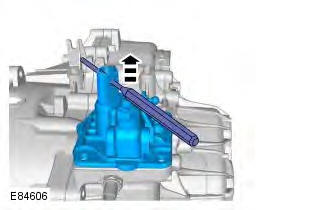
Installation
1. CAUTION: Make sure that the mating faces are clean and free of corrosion and foreign material.
NOTE: Apply a suitable amount of approved sealant to one of the mating faces.
To install, reverse the removal procedure.
Gearshift Lever
Removal
NOTES:
Removal steps in this procedure may contain installation details.
Some variation in the illustrations may occur, but the essential information is always correct.
1. Refer to: Floor Console (501-12 Instrument Panel and Console, Removal and Installation).
2. NOTE: Neutral must be selected before the cables are released to allow the cables to be correctly set on the install.
Install the gear selector knob.
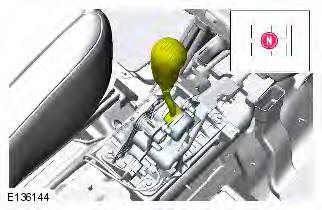
3.
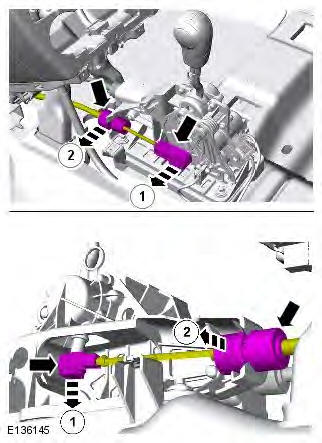
4. Torque: 10 Nm
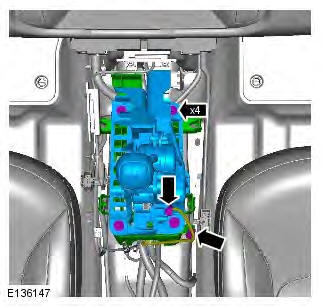
5. Remove the gear selector knob.
Installation
1. To install, reverse the removal procedure.
2.
- Release the LH cable securing clip.
- Allow the gearshift lever to come to rest in the neutral position.
- Secure the cable selector clip, without disturbing the gearshift selector lever position.
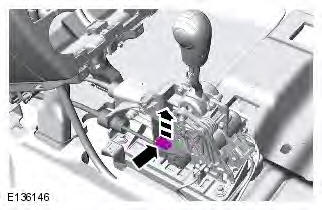
Gearshift Lever Knob
Removal
NOTE: Removal steps in this procedure may contain installation details.
1. WARNING: The selector lever knob will be released suddenly, keep face clear during removal.
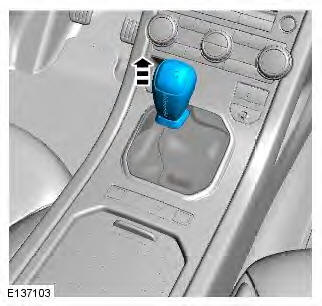
Installation
1. To install, reverse the removal procedure.
Gearshift Cables
Removal
NOTES:
Removal steps in this procedure may contain installation details.
Some variation in the illustrations may occur, but the essential information is always correct.
1. WARNING: Make sure to support the vehicle with axle stands. Raise and support the vehicle.
2. Refer to: Wheel and Tire (204-04 Wheels and Tires, Removal and Installation).
3. Refer to: Air Cleaner (303-12, Removal and Installation).
4. Refer to: Floor Console (501-12 Instrument Panel and Console, Removal and Installation).
5. NOTE: Neutral must be selected before the cables are released to allow the cables to be correctly set on the install. Install the gear selector knob.
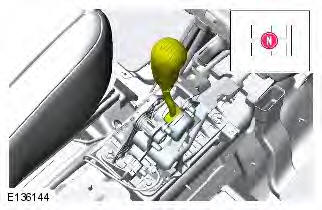
6.
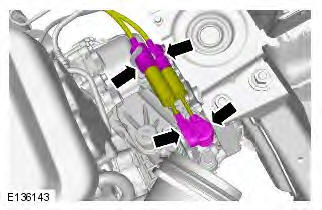
7.
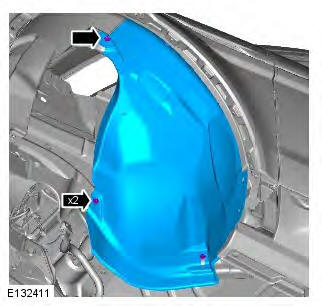
8.
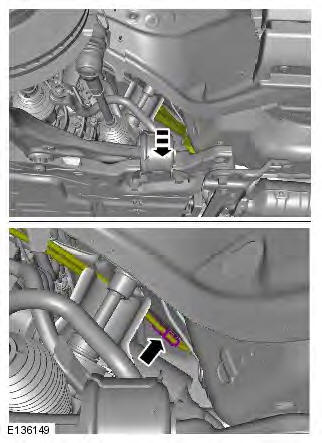
9.
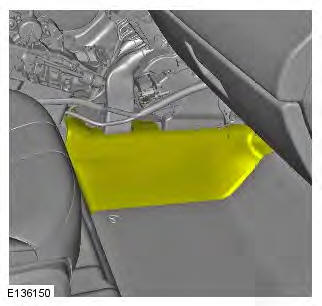
10.
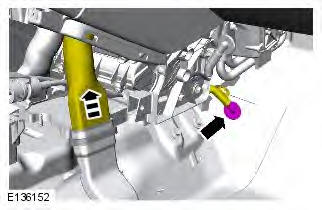
11. Torque: 25 Nm
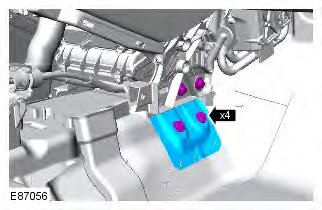
12. Torque: 7 Nm
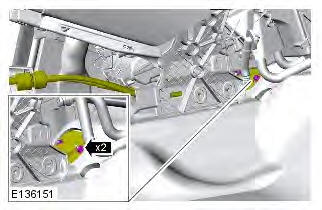
13.
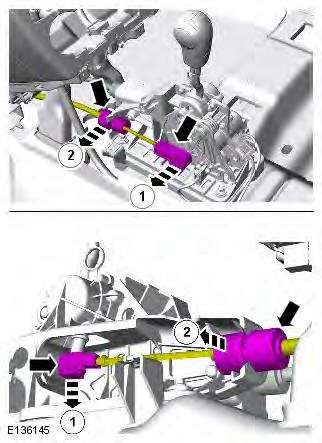
14. Torque: 10 Nm
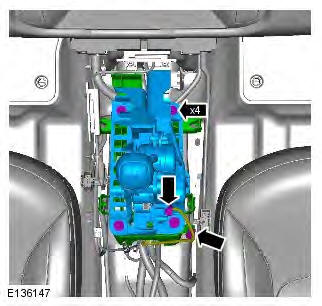
15. Remove the gear selector knob.
16. NOTE: This step requires the aid of another technician.
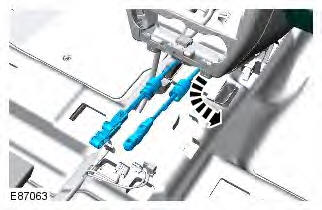
Installation
1. To install, reverse the removal procedure.
2.
- Release the LH cable securing clip.
- Allow the gearshift lever to come to rest in the neutral position.
- Secure the cable selector clip, without disturbing the gearshift selector lever position.
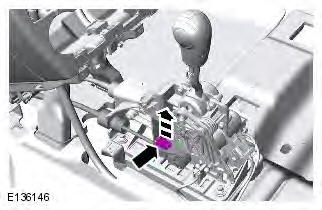
External Controls
Principles of Operation
For additional information. REFER to: Manual Transaxle and Clutch (308-03 Manual Transmission/Transaxle and Clutch - General Information, Diagnosis and Testing).
REFER to: Manual Transmission (308-03 Manual Transmission/Transaxle, Diagnosis and Testing).

